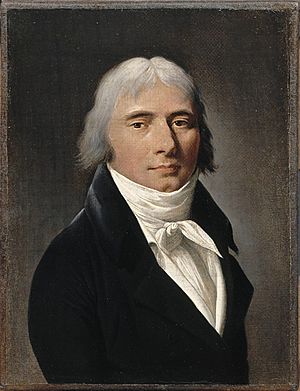Pierre Paul Royer-Collard facts for kids
Quick facts for kids
Pierre Paul Royer-Collard
|
|
|---|---|

Portrait by Louis-Léopold Boilly, 1819
|
|
| President of the French Chamber of Deputies | |
| In office 25 May 1828 – 16 May 1830 |
|
| Preceded by | Auguste Ravez |
| Succeeded by | Casimir Perier |
| Member of the French Chamber of Deputies | |
| In office 25 August 1815 – 5 July 1831 |
|
| Constituency | Marne |
| Member of the Council of Five Hundred | |
| In office 21 March 1797 – 4 September 1797 |
|
| Constituency | Marne |
| Councillor of the Paris Commune for the 4th arrondissement |
|
| In office 20 July 1789 – 10 August 1792 |
|
| Personal details | |
| Born | 21 June 1763 Sompuis, Champagne, France |
| Died | 2 September 1845 (aged 82) Châteauvieux, Loir-et-Cher, France |
| Political party | Girondin (1791–1793) Clichyen (1794–1797) Legitimist (1797–1815) Doctrinaire (1815–1831) |
| Spouse | Augustine de Forges de Chateaubrun |
| Children | 4 children |
| Alma mater | Saint-Omer College |
| Profession | Lawyer, teacher, philosopher |
Pierre Paul Royer-Collard (born June 21, 1763 – died September 2, 1845) was an important French politician and thinker. He led a group called the Doctrinaires during a time in France known as the Bourbon Restoration (1814–1830).
Contents
Pierre Royer-Collard's Life Story
Early Life and Education
Pierre Paul Royer-Collard was born in Sompuis, a town near Vitry-le-François in what is now the Marne region of France. His father, Anthony Royer, was a small businessman. His mother, Angélique Perpétue Collard, was known for being strong and very religious.
When Pierre was 12, he went to a college in Chaumont. His uncle, Father Paul Collard, was the director there. Later, he followed his uncle to Saint-Omer, where he studied mathematics. His younger brother, Antoine-Athanase Royer-Collard, became a doctor and was a pioneer in the field of psychiatry.
Starting His Career
Pierre Royer-Collard became a lawyer in Paris. When the French Revolution began, he was very excited about it. He was chosen by his local area, the Island of Saint-Louis, to join the Paris Commune. He worked as its secretary from 1790 to 1792.
After a major event on August 10, 1792, he was replaced by Jean-Lambert Tallien. Royer-Collard supported a group called the Girondins. After another uprising on May 31, 1793, his life was in danger. He went back to Sompuis and was saved from arrest, possibly with help from Georges Danton.
Political Roles and Philosophy
In 1797, he was elected to the Council of Five Hundred for his region, Marne. There, he worked closely with Camille Jordan. He gave a well-known speech defending the idea of religious freedom. However, a political takeover on September 4, 1797, forced him to leave public life.
During this time, he started to believe strongly in the idea of bringing back the old French monarchy. He even communicated with the future King Louis XVIII of France. He was a key person in a small group in Paris that wanted to restore the monarchy. But when Napoleon Bonaparte took power, Royer-Collard realized that bringing back the monarchy wasn't possible for a while.
From then until the monarchy was restored, Royer-Collard focused on studying philosophy. He disagreed with the ideas of Étienne Bonnot de Condillac. Instead, he studied René Descartes and the thinkers from Port-Royal. He wanted to create a system for moral and political education that would help France. From 1811 to 1814, he taught at the Sorbonne.
Return to Politics
This period marked the beginning of his long friendship with François Guizot. When the monarchy was first restored, Royer-Collard was in charge of supervising the press. From 1815, he served as a representative for Marne in the French parliament.
As the head of the public education committee from 1815 to 1820, he stopped the church from taking too much control. He retired when there was an attempt to give diplomas to teachers from the Christian Brothers without them having to pass university exams.
Even though Royer-Collard supported the monarchy, he also believed in the social changes that happened during the 1789 Revolution. He spoke out against unfair laws in 1815, 1820, and again during the July Monarchy.
The Doctrinaires
He was the main leader of a group called the "Doctrinaires". They met at the home of the comte de Ste Aulaire and in the salon of Madame de Staël's daughter, the duchesse de Broglie. Other important members of this group included Guizot, PFH de Serre, Camille Jordan, and Charles de Rémusat.
In 1820, Royer-Collard was removed from the council of state by a decision signed by his former friend, Serre. In 1827, he was elected to parliament in seven different areas, but he chose to represent his home region. The next year, he became president of the parliament. He fought against the strict policies that led to the Revolution of July. In March 1830, it was Royer-Collard who presented an important address from 221 members of parliament.
After that, he didn't take an active part in politics, but he remained in parliament until 1839. While many people who were considered "liberal" in the early 1800s were against the Jesuits, Royer-Collard showed respect for the Church. He believed that if Christianity was good for humanity, then attacking it, as Voltaire did, was a great mistake. He even called the Jesuits a "wonderful creation."
Personal Life and Later Years
Pierre Royer-Collard married Augustine Marie Rosalie de Forges de Chãtaeubrun on October 20, 1800. They had four children, but two of them passed away before their parents.
He died at his estate in Châteauvieux, which is in the Berry region, south of Blois.
See also
 In Spanish: Pierre-Paul Royer-Collard para niños
In Spanish: Pierre-Paul Royer-Collard para niños

